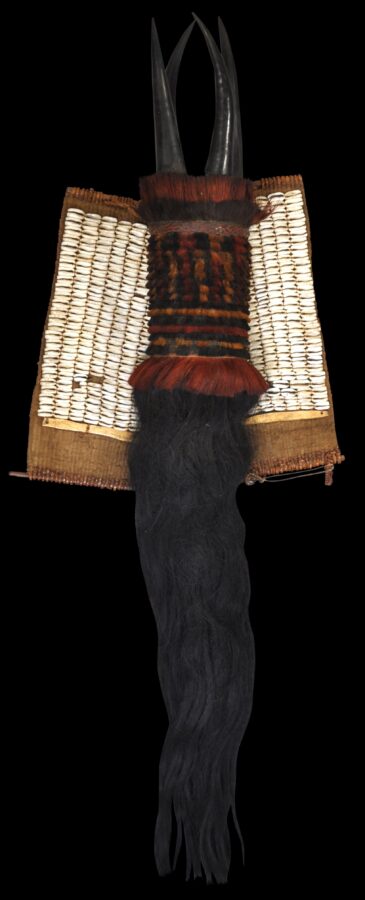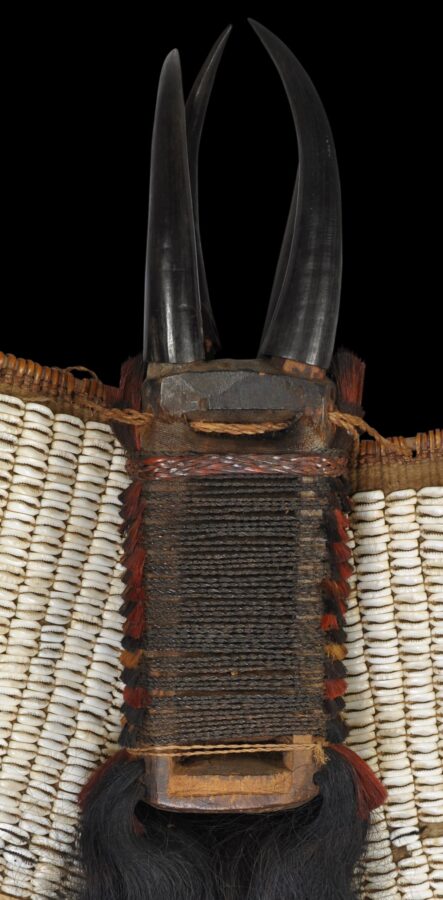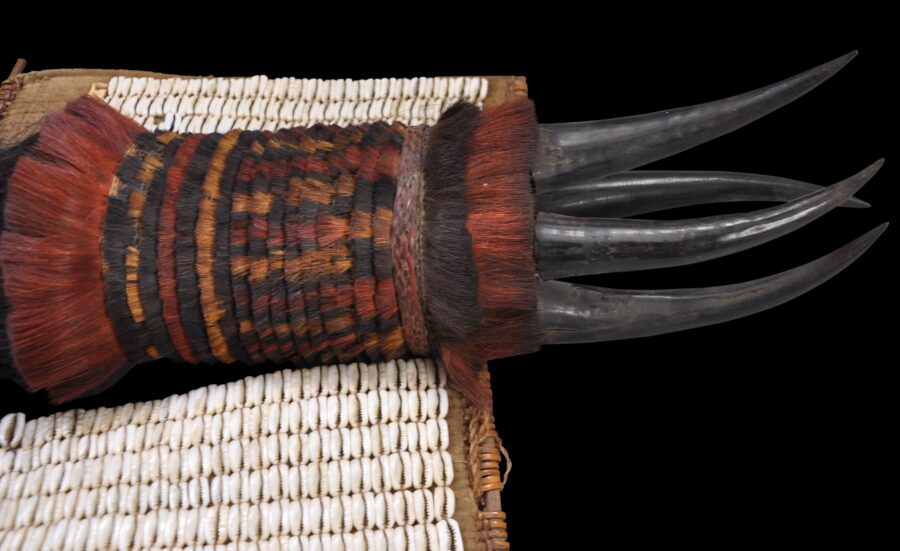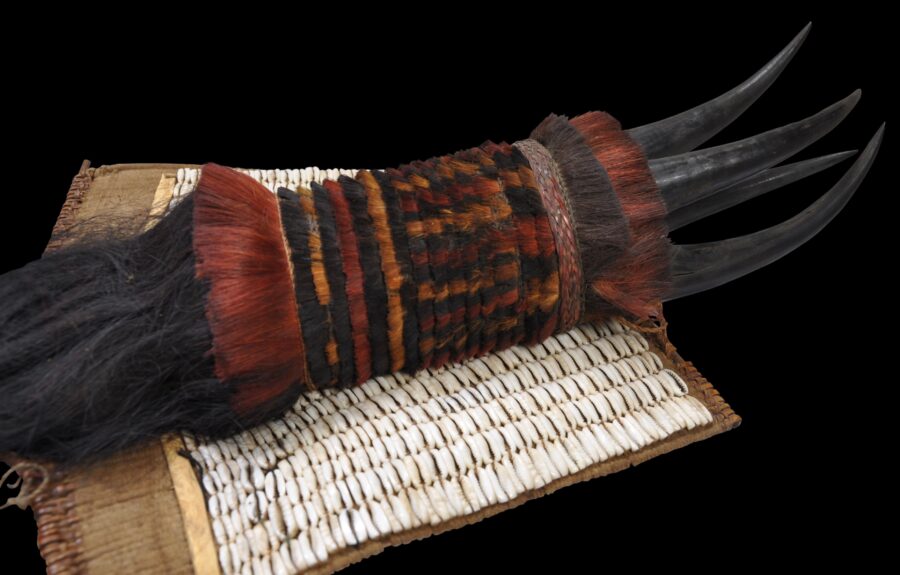Enquiry about object: 9897
Massive Naga Warrior’s Ceremonial Hip Ornament
Konyak Naga, North-Eastern India late 19th-early 20th century
length of wooden substrate: approximately 17.4cm, overall length (including horns and hair): approximately 80cm, dimensions of 'wings': approximately 18 and 11 cm individually, weight: 853g
Provenance
Hansjorg Mayer Collection, UK
This extraordinary and rare item is a large ornament that was worn by Naga warrior men on their hips on ceremonial occasions. It comprises a wooden substrate covered with finely woven rattan strips on one (flat) side and bands of dyed goat hair on the (rounded) other; a top decorated with the tips of four serow (wild goat-antelope) horns; two ‘wings’ of woven rattan strips each decorated on one side with rows of cowrie shells; and a long, thick tassel of long, dark human hair, as befitting a headhunting culture.
Such an ornament was worn as a clear display of status and wealth.
The Naga people are concentrated in Eastern India. Smaller numbers are also in western Burma. The Naga themselves are divided into at least 15 major ethnic subgroups: the Angami, Ao, Chakhesang, Chang, Khiamniungan, Konyak, Lotha, Phom, Pochury, Rengma, Sangtam, Sümi, Tikhir, Yimkhiung, and the Zeme-Liangmai (Zeliang). They speak as many as 30 sometimes mutually unintelligible dialects. Traditionally, they were animists. Each group had their own ceremonial attire.
The area in India where the Nagas, who are believed to be of Mongolian descent, are concentrated was recognised as its own state, Nagaland, in 1977. It is a relatively remote, mountainous and landlocked region, but it was not remote from trade. The Nagas largely were farmers but general trade also was another economic activity, one in which both women and men participated. Costume and ornament making were a significant commercial activity. Some Naga tribes made no ornaments at all but instead bought them from other tribes.
The Naga appreciated imported glass beads and seashell components greatly for their jewellery and other adornment. Typically, the seashells were traded in from the Bay of Bengal. The beads came from India, and also much further afield such as Venice. Metal elements were also used. These were cast locally or imported, mostly from India. The Nagas traditionally were head hunters, and the jewellery of the menfolk reflected the preoccupation with ancestor worship and one’s prowess at hunting and taking heads.
Jewellery items were highly prized and were treated as heirlooms to be passed from family member to family member. Components of necklaces such as individual beads were prized just as much as overall jewellery pieces, and so often beads and other jewellery components would be used and re-used. Jewellery items would be amended and remade according to need and as a family’s wealth and prestige grew. But by the 1970s, the Nagas no longer wore much traditional jewellery and jewellery making for traditional purposes largely stopped. Most Nagas had also converted to Christianity (Baptist mostly), and the taking of heads had long stopped, having been largely supressed by the British in the early 20th century. As with any evolving society, heirloom pieces were traded for items that improved a family’s well-being – medicines, household appliances and so on.
The necklace here is from the collection of well known artist, printer and art publisher Hansjorg Mayer (b. 1943) who built up a large collection of Naga jewellery over a 50-year period, commencing in the early 1970s. Mayer’s works are to be found in the Tate Britain and other museums in Europe.
Illustrated: This actual item is illustrated in Jacobs, J., The Nagas: Hill Peoples of Northeast India, Thames & Hudson, 1990, page 241.
It is in very fine condition, with splendid age only minor losses to the dyed pig hair covering to the main element and some cowrie shells are deficient.
References
Ao, A. S., Naga Tribal Adornment: Signatures of Status and Self, The Bead Society of Greater Washington, 2003.
Barbier, J.P., Art of Nagaland: The Barbier-Muller Collection Geneva, Los Angeles County Museum of Art, 1984.
Giehmann, M., Naga Treasures: Tribal Adornment from the Nagas – India and Myanmar, 2001.
Jacobs, J., The Nagas: Hill Peoples of Northeast India, Thames & Hudson, 1990.
Saul, J.D., The Naga of Burma: Their Festivals, Customs and Way of Life, Orchid Press, 2005.
Shilu, A., Naga Tribal Adornment: Signatures of Status and Self, The Bead Museum, Washington, 2003.
Untracht, O., Traditional Jewelry of India, Thames & Hudson, 1997.







